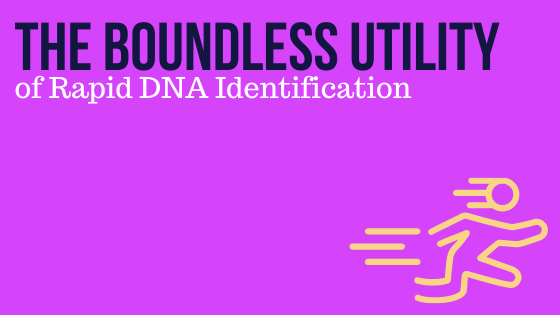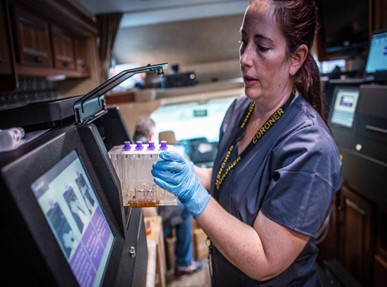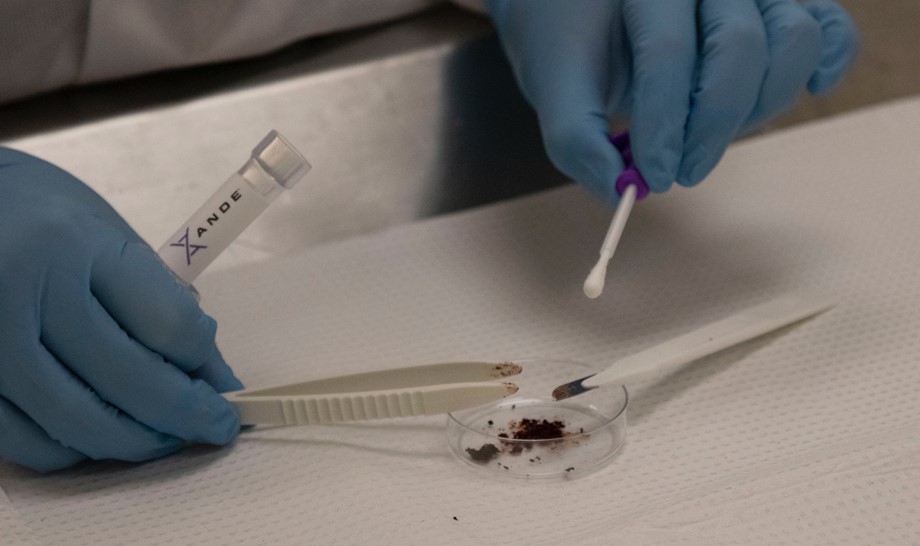Today’s blog is written by Julie L. French, Senior Vice President of Global Scientific Support, ANDE Corporation. Read the full version in the February 2021 issue of The ISHI Report.
Rapid DNA Identification has been successfully used by agencies around the world for over 10 years. Even so, sometimes it is still referred to as a new technology – why is that? Perhaps the answer lies in the countless different uses for rapid DNA, and each time it is applied in a new way, it seems, well…new. This article will present an overview of the most common applications for rapid DNA and discuss how to implement a rapid DNA program with confidence. Let’s start with the application that was first NDIS-approved back in 2016 – ANDE Rapid DNA testing in an accredited forensic laboratory.
Forensic Laboratory Use of Rapid DNA
Databasing laboratories are approved to use rapid DNA to test reference buccal swabs for direct upload into the FBI’s National DNA Index System (NDIS). This can be a complementary technology used to increase sample throughput, or a tool that allows work to continue when analysts have limited lab time or have to work from alternate locations – such as when COVID-19 restrictions are in place. Also, CODIS hit confirmations are always time sensitive and typically consist of small batches of samples – a perfect fit for rapid DNA testing.
The practicality of rapid DNA testing in casework laboratories is often undervalued. Most labs have methods optimized to process large batches of samples. This works well because, with DNA being a powerful tool for criminal prosecution, labs continue to be inundated with a large volume of cases. But, what about that small number of samples that need to be quickly tested to eliminate possible suspects in a high-profile, time-sensitive case? Rapid DNA offers significant value because samples can be processed quickly without disrupting the casework batch processing already underway.
Laboratory applications for rapid DNA have continued to expand with testing of samples from sexual assault cases. As presented at the ISHI 2019 meeting, the Kentucky State Police has been at the forefront of rapid DNA use; testing post coital swabs followed by searching of the resultant profiles against their state data. Accelerating the testing of sexual assault evidence is solving cases faster. Every step taken to help victims of sexual assault and violence is an important one and one worth taking. Today this processing is happening in the lab, but the simplicity of rapid DNA means a transition to medical facilities is within reach.
Booking Stations and Arrestee Enrollments
Next, let’s move to the booking station where history was made the first week of February 2021 when the ANDE Series G System became the first rapid DNA system approved by the FBI for use in law enforcement booking stations. During the booking process, arrested individuals are moved through biometric capture stations where fingerprints, mugshots, and other biometric data is recorded. In many states, DNA is one of those biometrics and the DNA samples have historically been collected and mailed to forensic laboratories for processing. Now, those samples can be processed right at the point of collection. The results are automatically sent to NDIS where matches can be made to unsolved cases and results returned to the booking station while the individual is still in custody. This will make our communities safer.
DNA Identification of Decedents
A quick DNA test is useful to Medical Examiners and Coroners in every case; this technology helps bring answers to the families in times of tragedy. Rapid DNA can generate a DNA profile from blood, tissue, or bone to be compared with family members who have donated their buccal swabs. Rapid DNA results can also allow the reassociation of limbs that may have become separated during vehicle accidents or other non-criminal or criminal acts. In the event of disaster events such as fires, hurricanes, or airline crashes, the rapid DNA instrument can be mobilized to the scene for fast processing of samples from unidentified human remains. Since the operation of the system is simple, just-in-time training for operation of the system can be provided right on site. The days of waiting a year or more to generate DNA results from a single bone needs to be a thing of the past.
Investigative Leads for Criminal Cases
With a focus on improving public safety and aiding investigations, the use of rapid DNA testing on evidentiary samples, even without access to a large database, is an incredibly powerful tool. An agency can control their own investigation by deciding to test multiple samples from a scene to determine if they match the victim, the homeowner, or if they are from a possible perpetrator. Obtaining this information in near real time, while the crime scene is still under the control of the agency, can be the key to ultimately solving the case. It may also result in fewer samples submitted to the laboratory, focusing their efforts only on those samples needed for prosecution of the case. Immediate DNA results not only steer the investigation – but suspects frequently plead guilty when presented with the results from rapid DNA testing.
Training and Implementation – A Key to Success
It is critical to have a training and implementation plan, not only to ensure proper sample collection and system operation, but also to provide foundational knowledge and support for the establishment of a successful rapid DNA program. Operating the instrument is incredibly simple and can be demonstrated in less time than it took to read this article. Beyond operational training, it is important that users review all published standards, best practice recommendations and guidelines related to rapid DNA issued by the FBI, SWGDAM, OSAC, and other working groups. Other implementation activities may include evaluating existing sample collection procedures, conducting an internal validation, discussion of peer-reviewed publications, and collaborating with other agencies currently using rapid DNA.
Once the foundation is set, those tasked with writing policies and procedures should keep it simple – writing straightforward, clear procedures and policies about who, when and how rapid DNA and the resulting matches will be used. When drafting policies, topics to consider include case selection, duplicate swab collection, sample naming conventions, and tracking metrics related to the use of rapid DNA. Current users are often happy to share their policies and this can be a great starting point for new programs.
In addition to the use of a proven underlying technology, successful rapid DNA programs consist of trained users, clear policies and procedures, and an active interest in advancing investigations immediately. The utility of rapid DNA is limited only by the artificial constraints imposed on it. In practice, any time a fast biometric comparison would make the world a safer place is a great time to utilize rapid DNA.
WOULD YOU LIKE TO SEE MORE ARTICLES LIKE THIS? SUBSCRIBE TO THE ISHI BLOG BELOW!
SUBSCRIBE NOW!





